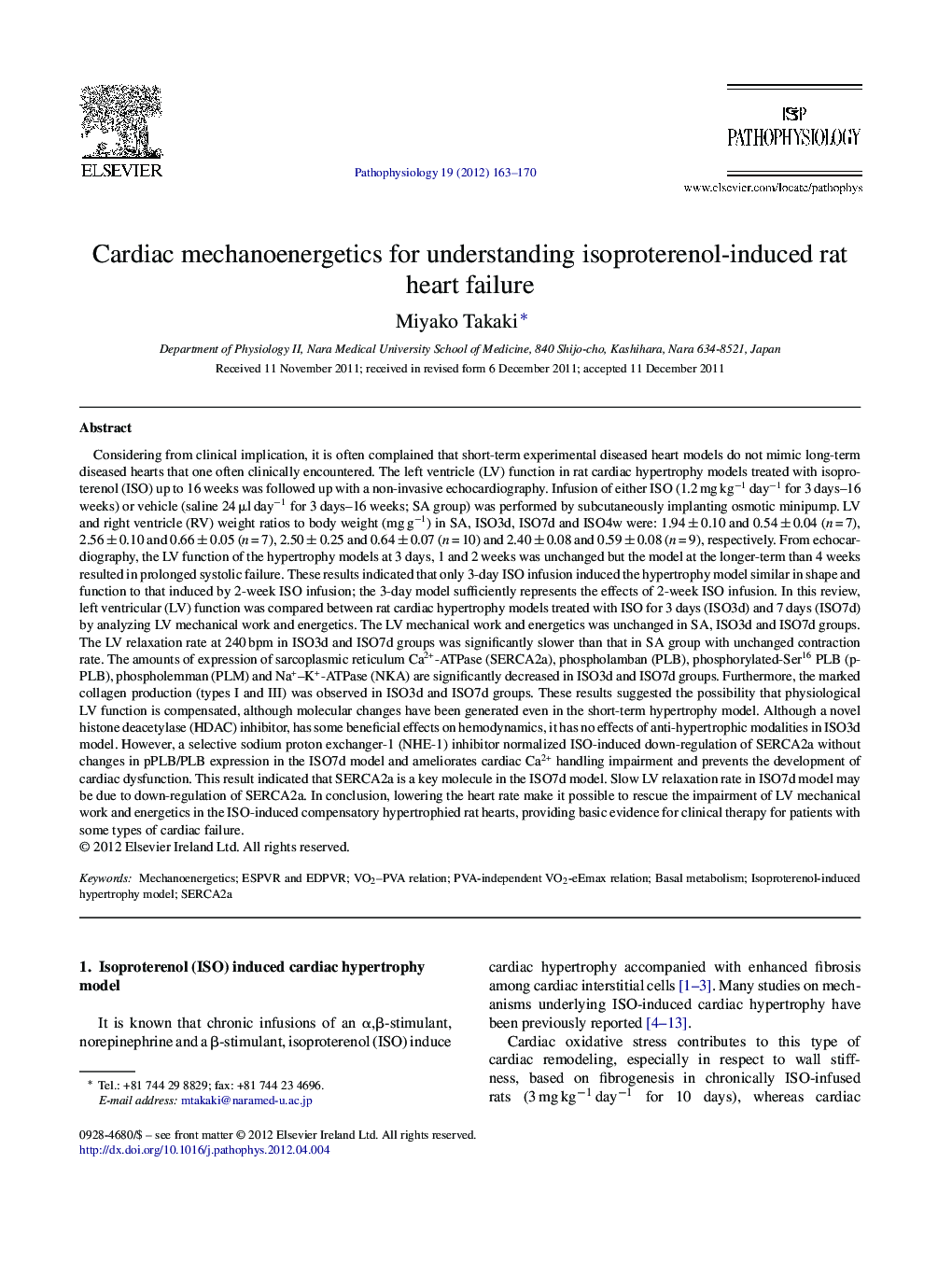| کد مقاله | کد نشریه | سال انتشار | مقاله انگلیسی | نسخه تمام متن |
|---|---|---|---|---|
| 4137222 | 1272015 | 2012 | 8 صفحه PDF | دانلود رایگان |

Considering from clinical implication, it is often complained that short-term experimental diseased heart models do not mimic long-term diseased hearts that one often clinically encountered. The left ventricle (LV) function in rat cardiac hypertrophy models treated with isoproterenol (ISO) up to 16 weeks was followed up with a non-invasive echocardiography. Infusion of either ISO (1.2 mg kg−1 day−1 for 3 days–16 weeks) or vehicle (saline 24 μl day−1 for 3 days–16 weeks; SA group) was performed by subcutaneously implanting osmotic minipump. LV and right ventricle (RV) weight ratios to body weight (mg g−1) in SA, ISO3d, ISO7d and ISO4w were: 1.94 ± 0.10 and 0.54 ± 0.04 (n = 7), 2.56 ± 0.10 and 0.66 ± 0.05 (n = 7), 2.50 ± 0.25 and 0.64 ± 0.07 (n = 10) and 2.40 ± 0.08 and 0.59 ± 0.08 (n = 9), respectively. From echocardiography, the LV function of the hypertrophy models at 3 days, 1 and 2 weeks was unchanged but the model at the longer-term than 4 weeks resulted in prolonged systolic failure. These results indicated that only 3-day ISO infusion induced the hypertrophy model similar in shape and function to that induced by 2-week ISO infusion; the 3-day model sufficiently represents the effects of 2-week ISO infusion. In this review, left ventricular (LV) function was compared between rat cardiac hypertrophy models treated with ISO for 3 days (ISO3d) and 7 days (ISO7d) by analyzing LV mechanical work and energetics. The LV mechanical work and energetics was unchanged in SA, ISO3d and ISO7d groups. The LV relaxation rate at 240 bpm in ISO3d and ISO7d groups was significantly slower than that in SA group with unchanged contraction rate. The amounts of expression of sarcoplasmic reticulum Ca2+-ATPase (SERCA2a), phospholamban (PLB), phosphorylated-Ser16 PLB (p-PLB), phospholemman (PLM) and Na+–K+-ATPase (NKA) are significantly decreased in ISO3d and ISO7d groups. Furthermore, the marked collagen production (types I and III) was observed in ISO3d and ISO7d groups. These results suggested the possibility that physiological LV function is compensated, although molecular changes have been generated even in the short-term hypertrophy model. Although a novel histone deacetylase (HDAC) inhibitor, has some beneficial effects on hemodynamics, it has no effects of anti-hypertrophic modalities in ISO3d model. However, a selective sodium proton exchanger-1 (NHE-1) inhibitor normalized ISO-induced down-regulation of SERCA2a without changes in pPLB/PLB expression in the ISO7d model and ameliorates cardiac Ca2+ handling impairment and prevents the development of cardiac dysfunction. This result indicated that SERCA2a is a key molecule in the ISO7d model. Slow LV relaxation rate in ISO7d model may be due to down-regulation of SERCA2a. In conclusion, lowering the heart rate make it possible to rescue the impairment of LV mechanical work and energetics in the ISO-induced compensatory hypertrophied rat hearts, providing basic evidence for clinical therapy for patients with some types of cardiac failure.
► Short-term Isoproterenol-induced hypertrophied rat hearts are contracting normal.
► Diastolic function of these hypertrophied hearts is impaired.
► This diastolic failure is due to down-regulation of SERCA2a.
► Decreasing heart rate is critical to compensate heart failure.
Journal: Pathophysiology - Volume 19, Issue 3, June 2012, Pages 163–170